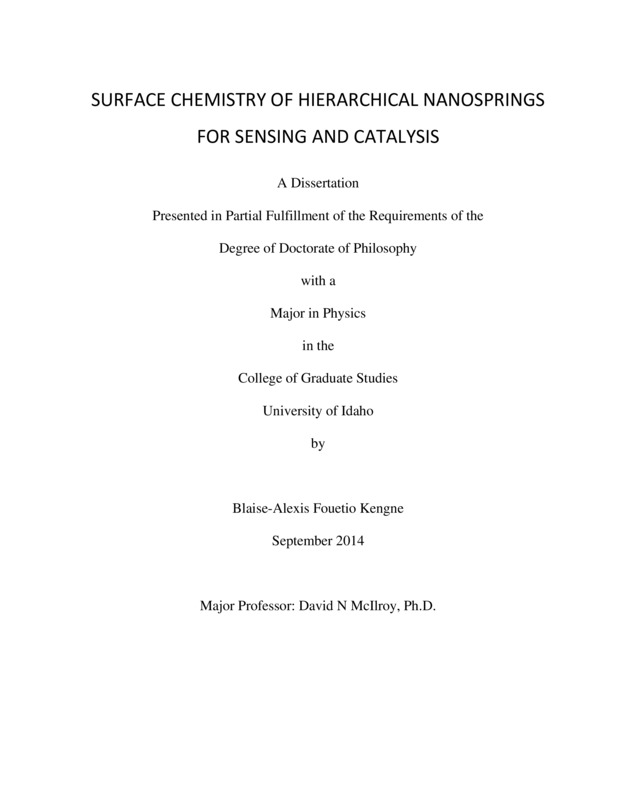SURFACE CHEMISTRY OF HIERARCHICAL NANOSPRINGS FOR SENSING AND CATALYSIS
Fouetio Kengne, Blaise-Alexis. (2014). SURFACE CHEMISTRY OF HIERARCHICAL NANOSPRINGS FOR SENSING AND CATALYSIS. Theses and Dissertations Collection, University of Idaho Library Digital Collections. https://www.lib.uidaho.edu/digital/etd/items/fouetiokengne_idaho_0089e_10372.html
- Title:
- SURFACE CHEMISTRY OF HIERARCHICAL NANOSPRINGS FOR SENSING AND CATALYSIS
- Author:
- Fouetio Kengne, Blaise-Alexis
- Date:
- 2014
- Keywords:
- Co catalysts Fischer-Tropsch synthesis gaseous analytes silica nanosprings thiols ZnO chemiresistors
- Program:
- Physics
- Subject Category:
- Nanoscience
- Abstract:
-
Silica nanosprings (NS) were grown and their surface chemistry was modified depending upon the application. For explosive detection, NS were subsequently coated with ZnO, decorated with metal nanoparticles, and functionalized with thiols; while NS supported cobalt catalysts (Co/NS) were prepared for Fischer-Tropsch synthesis (FTS). Scanning and transmission electron microscopies (SEM and TEM), X-ray diffraction (XRD), N2 physisorption, H2-temperatature programmed reduction (H2-TPR, and X-ray and ultraviolet photoelectron spectroscopies (XPS and UPS) have been used to characterize the hierarchical NS. Based on XPS analysis of the thiolated NS, a single S 2p core level is observed for 4-mercaptobenzoic acid and11-(1-pyrenyl)-1-undecathiol, which is assigned to the S-Au bond. The S 2p core level of L-cysteine, 6-mercaptohexanol and DL-thioctic acid consists of two doublets, where one is S-Au bond and the other is the S-Zn bond. UPS analysis shows that the hybridization of the S 3p states and the Au d-bands produces antibonding and bonding states, above and below the Au d-bands, which is characteristic of molecular chemisorption on Au nanoparticles. Gas sensors functionalized with functionalized with 4-mercaptobenzoic acid and 6-mercaptohexanol showed the strongest responses to ammonium nitrate by factors of 4 to 5, respectively, relative to the less responsive thiols. For FTS, even though Co/NS had 75 times less gravimetric Co content than the reference catalyst, without being fully reduced, it still showed higher activity. This is attributed to higher Co dispersion on NS and greater gases acessibility.
In situ XPS has been used to monitor the reduction of Co/NS. The analysis shows that cobalt is present in the starting catalyst as a Co3O4 spinel phase. At 385 ºC and 10-6 Torr of H2 a two-step reduction from Co3O4 to CoO and then to Co0 is observed, which is consistent with H2-TPR results. The two reduction steps are concurrent. The reduction saturates at the value of 41% after 20 hours, which correlates with the drop observed in FTS activity. Conversely, Co/NS is fully reduced at 680 ºC and 10 Torr of H2 after 10 hours. - Description:
- doctoral, Ph.D., Physics -- University of Idaho - College of Graduate Studies, 2014
- Major Professor:
- McIlroy, David Nevil
- Committee:
- Hedman, Matthew; Bergman, Leah; Aston, Eric
- Defense Date:
- 2014
- Identifier:
- FouetioKengne_idaho_0089E_10372
- Type:
- Text
- Format Original:
- Format:
- application/pdf
- Rights:
- In Copyright - Educational Use Permitted. For more information, please contact University of Idaho Library Special Collections and Archives Department at libspec@uidaho.edu.
- Standardized Rights:
- http://rightsstatements.org/vocab/InC-EDU/1.0/

